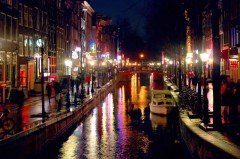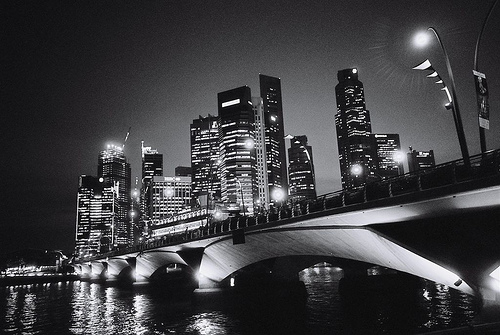
Night time provides excellent opportunity for photographers to get creative and explore unusual light conditions. Shooting during the night can be very challenging because of the limitations that the light poses. Here are some tips to help you take some excellent, colorful and beautiful shots during the night:
- Flash: The first thing a beginner will do is to fire the flash. The art lies in understanding the reach and effect of flash and where and how to get the best results. Flash is generally used to illuminate people or to bounce off light and control the shadows. Using flash for night scenes without any/little ambient light is an absolute waste. Carry an external flash unit and battery if required. External flash are preferred over the built-in flash of the DSLRs and compacts as they provide more even and softer light (suited for portraits).
- Lens: The bare levels of light during the night warrant equipment and techniques that help you collect more light. Go for a lens with a wider aperture. Generally prime lenses suit this purpose. Lenses with built-in vibration-reduction or image-stabilization are recommended.
- The Full-Frame Advantage: The full-frame cameras have a bigger light sensor. Due to the extra surface area, more light is captured and low-light performance of the camera is boosted. Also these cameras have excellent noise performance characteristics and can go up to insane ISO ratings with perfectly usable results.
- The Less Mega-Pixel Advantage: This is purely hypothetical and speculative based on reasoning alone. Given a standard sensor size, a lower megapixel count will mean larger sensor-pixels which will have better noise performance characteristics owing to their larger surface area equipping them to collect more light. But this would indeed mean a camera with pretty few mega-pixel. Your inputs are invited in the comments section.
- Shutter Speed: Due to the absence of light, you must open the shutter for longer time. Since you have to keep the shutter speed slow, you also have to ensure that the camera and the subject don’t move else this may result in an ugly blur. This brings us to the next point.
- Tripod: Invest in a sturdy tripod. It comes in handy often during indoor and low-light shoots or even in scenes requiring show shutter speed or just a timer-triggered shots. You compose, fix and leave (or stay to press the trigger). You can work around the requirement of a tripod by supporting your camera against a sturdy surface or by placing it on something stable and then pressing the shutter-release. Also you may want to try the timer or remote trigger to avoid shaking the camera when releasing the shutter. Use the mirror-lock to reduce camera shake during the shutter-release.
- Auto ISO: Set your camera to auto ISO. If you set the ISO manually, the camera will be confined to correct the exposure using shutter-speed and aperture only resulting in unpredictable artifacts in low-light conditions like blur, movement etc. Auto ISO will boost the sensor’s sensitivity to light avoiding the need to decrease shutter-speed beyond what is really required.
- Large Aperture: Even with the aperture wide-open, there’s not much light that you can collect. But leaving it at the widest (low f-stop/f-number) certainly helps.
- Flash Mode: Your camera may offer you various flash-firing modes for effectively capturing moving subjects at night. A slow flash will illuminate your subject longer, a rear firing flash will make the flash fire right before the shutter is about to complete the shot and close down. This allows the camera to collect the ambient light and then finally fire the flash to illuminate the subject and close the shutter, killing the scope for any bulr.
- Night Mode: An easy mode to help you hand over the camera to kids or friends to set them up for photography. Depending on the camera there may be two kinds of night modes — one that offers you flash (best for portraits) and other which tries to capture subjects in ambient light like the moon or city light or fireworks etc.
- Try Black and White: There’s a beauty and effect of reflections, glows and light effects which goes beyond the realm of color. But insist on shooting in color and convert to black and white only during the post-processing. This allows you more flexibility, options and greater variety of results when doing the conversion.
- Noise Considerations: Shooting in low light generally requires the ISO boosted to insane levels which in-turn results in a lot of color noise and grain. Some cameras have built-in noise reduction. I prefer to take care of the noise during the post-processing phase because the computer, software allow wider and highly sophisticated options to get rid of the ISO noise.
- Shoot At Dusk and Dawn: Ambient light at dusk and dawn has a surreal quality and tone to it. Also referred to as the magic light this light can give you very pleasing colors and tones in your results.
- Use Manual/Semi-Auto Modes: As a professional and an artist (a perfectionist) you will mostly have to shoot in one of the semi-manual (semi-automatic) or fully-manual modes. Mostly you will be shooting in the shutter-priority modes to control the motion-blur.
- White Balance: Due to the variety of available sources of light at night, your camera may be tricked to use incorrect white balance. If you are shooting RAW, you can take care of this during the post-processing. In case you shoot JPEG, just note that you may want to check your results right then and there to ensure proper expected results. Use the LCD on your DSLR to preview the JPEG.
- Shoot Fairgrounds and Traffic: Moving sources of light create interesting shapes and outlines when exposed using a slow shutter-speed. Static sources of light create colorfully glowing objects in the result.
- Fireworks: Fireworks can be tricky to shoot. One missed moment can result in a perfect shot ruined. The best way to work this out is to shoot in continuous mode and capture multiple shots. Later you can copy them to your computer and choose and pick the best. A fast focusing camera and lens combination certainly helps.
- Indoors: Flash can be tricky to say the least, especially in low-light. If you can, work out your shot in ambient light using a higher ISO setting or else stick to the night portrait mode of the camera.



Hi,
I am a novice in photography.
How does a lower megapixel camera or camera setting help shoot better night photos?
Can you please clarify more on this?
Thank you in advance.
You’ve sent through some fantastic photographs in the newsletter. It would be great to know how they were achieved though. thanks!